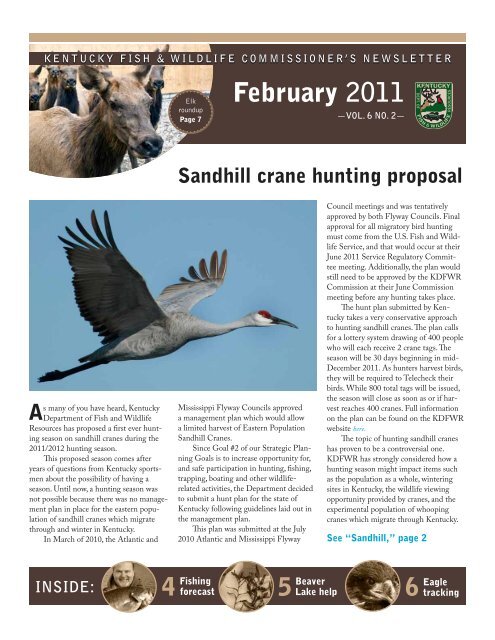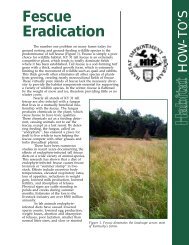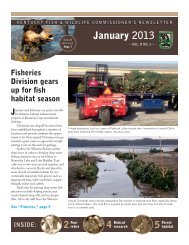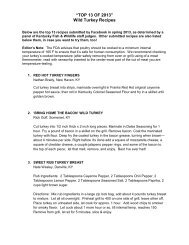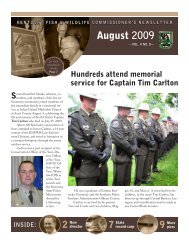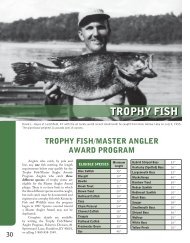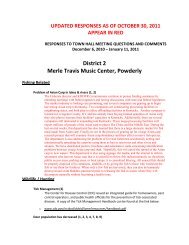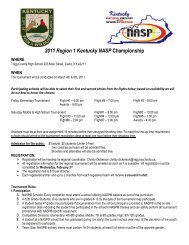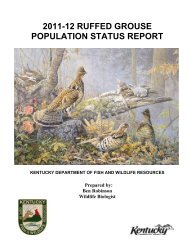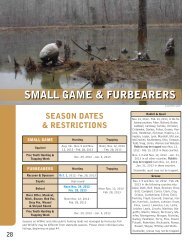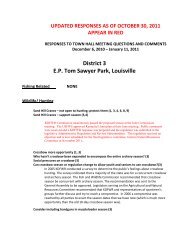February 2011 Newsletter - Kentucky Department of Fish and ...
February 2011 Newsletter - Kentucky Department of Fish and ...
February 2011 Newsletter - Kentucky Department of Fish and ...
Create successful ePaper yourself
Turn your PDF publications into a flip-book with our unique Google optimized e-Paper software.
KENTUCKY FISH & WILDLIFE COMMISSIONER’S NEWSLETTER<br />
As many <strong>of</strong> you have heard, <strong>Kentucky</strong><br />
<strong>Department</strong> <strong>of</strong> <strong>Fish</strong> <strong>and</strong> Wildlife<br />
Resources has proposed a first ever hunting<br />
season on s<strong>and</strong>hill cranes during the<br />
<strong>2011</strong>/2012 hunting season.<br />
This proposed season comes after<br />
years <strong>of</strong> questions from <strong>Kentucky</strong> sportsmen<br />
about the possibility <strong>of</strong> having a<br />
season. Until now, a hunting season was<br />
not possible because there was no management<br />
plan in place for the eastern population<br />
<strong>of</strong> s<strong>and</strong>hill cranes which migrate<br />
through <strong>and</strong> winter in <strong>Kentucky</strong>.<br />
In March <strong>of</strong> 2010, the Atlantic <strong>and</strong><br />
INSIDE:<br />
4<br />
Elk<br />
roundup<br />
Page 7<br />
<strong>Fish</strong>ing<br />
forecast<br />
<strong>February</strong> <strong>2011</strong><br />
5<br />
Beaver<br />
Lake help<br />
—VOL. 6 NO. 2—<br />
S<strong>and</strong>hill crane hunting proposal<br />
Mississippi Flyway Councils approved<br />
a management plan which would allow<br />
a limited harvest <strong>of</strong> Eastern Population<br />
S<strong>and</strong>hill Cranes.<br />
Since Goal #2 <strong>of</strong> our Strategic Planning<br />
Goals is to increase opportunity for,<br />
<strong>and</strong> safe participation in hunting, fishing,<br />
trapping, boating <strong>and</strong> other wildliferelated<br />
activities, the <strong>Department</strong> decided<br />
to submit a hunt plan for the state <strong>of</strong><br />
<strong>Kentucky</strong> following guidelines laid out in<br />
the management plan.<br />
This plan was submitted at the July<br />
2010 Atlantic <strong>and</strong> Mississippi Flyway<br />
Council meetings <strong>and</strong> was tentatively<br />
approved by both Flyway Councils. Final<br />
approval for all migratory bird hunting<br />
must come from the U.S. <strong>Fish</strong> <strong>and</strong> Wildlife<br />
Service, <strong>and</strong> that would occur at their<br />
June <strong>2011</strong> Service Regulatory Committee<br />
meeting. Additionally, the plan would<br />
still need to be approved by the KDFWR<br />
Commission at their June Commission<br />
meeting before any hunting takes place.<br />
The hunt plan submitted by <strong>Kentucky</strong><br />
takes a very conservative approach<br />
to hunting s<strong>and</strong>hill cranes. The plan calls<br />
for a lottery system drawing <strong>of</strong> 400 people<br />
who will each receive 2 crane tags. The<br />
season will be 30 days beginning in mid-<br />
December <strong>2011</strong>. As hunters harvest birds,<br />
they will be required to Telecheck their<br />
birds. While 800 total tags will be issued,<br />
the season will close as soon as or if harvest<br />
reaches 400 cranes. Full information<br />
on the plan can be found on the KDFWR<br />
website here.<br />
The topic <strong>of</strong> hunting s<strong>and</strong>hill cranes<br />
has proven to be a controversial one.<br />
KDFWR has strongly considered how a<br />
hunting season might impact items such<br />
as the population as a whole, wintering<br />
sites in <strong>Kentucky</strong>, the wildlife viewing<br />
opportunity provided by cranes, <strong>and</strong> the<br />
experimental population <strong>of</strong> whooping<br />
cranes which migrate through <strong>Kentucky</strong>.<br />
See “S<strong>and</strong>hill,” page 2<br />
6<br />
Eagle<br />
tracking
2<br />
KENTUCKY FISH & WILDLIFE COMMISSIONER’S NEWSLETTER<br />
Hunter Education Instructor<br />
Appreciation Banquet<br />
The Hunter Education Program hosted<br />
the annual Hunter Education Instructor<br />
Appreciation Banquet at Blue Licks<br />
Battlefield State Resort Park on January<br />
22, <strong>2011</strong>. There were 114 in attendance.<br />
Hunter Training Officer Bobby<br />
McKee presented Scott Barrow with the<br />
Hunter Education Conservation Officer <strong>of</strong><br />
“S<strong>and</strong>hill,” continued<br />
In every way this plan attempts<br />
to be conservative. The harvest <strong>of</strong> 400<br />
cranes from a population which exceeds<br />
60,000 will not slow the rapid growth <strong>of</strong><br />
this population. Wildlife viewing is an<br />
incredibly important <strong>and</strong> growing wildlife<br />
related activity in <strong>Kentucky</strong>.<br />
This plan was devised to close the<br />
season before peak viewing opportunities<br />
at the s<strong>and</strong>hill crane weekends at Barren<br />
River State Resort Park. It is also timed<br />
so that the season opens after whooping<br />
cranes have moved through <strong>Kentucky</strong>.<br />
the Year award.<br />
A very special thank you to Law<br />
Enforcement’s Color Guard Team who<br />
opened the ceremony. Also, thanks to Paul<br />
Eldridge <strong>and</strong> John Akers for making door<br />
prize <strong>and</strong> silent auction items for the <strong>Kentucky</strong><br />
Hunter Education Association.<br />
Lots <strong>of</strong> thought <strong>and</strong> effort has gone into<br />
this plan so that it will provide additional<br />
hunting activity without damaging the<br />
watchability <strong>of</strong> this incredible resource.<br />
It is possible that many <strong>of</strong> you have<br />
already gotten questions about this issue.<br />
There is a frequently asked question section<br />
on the website above which deals<br />
with many <strong>of</strong> the question we have already<br />
heard. If you have additional questions or<br />
concerns, we welcome your input. Please<br />
encourage those that want to express<br />
opinions on the season to write the Commissioner’s<br />
<strong>of</strong>fice.<br />
WE GET MAIL<br />
Letters to the<br />
Commissioner’s Office<br />
This e-mail was received through the Information<br />
Center. It’s another reminder<br />
that a seemingly minor act <strong>of</strong> sending<br />
some magazines to our servicemen <strong>and</strong><br />
women overseas does make a difference.<br />
This is Sgt Christopher M. Adcock.<br />
I am overseas in Afghanistan. I wanted to<br />
thank you for the box you sent me. It is<br />
very appreciated. Your support <strong>and</strong> prayers<br />
help us get through the days out here. To<br />
us you are the heroes. We have so many<br />
members out here who enjoy fishing <strong>and</strong><br />
hunting <strong>and</strong> love your magazines. On<br />
behalf <strong>of</strong> the 2123RD Trans company I<br />
would like to send out my deepest thank<br />
you on how you <strong>and</strong> your department<br />
have gave us a piece <strong>of</strong> home that we so<br />
desperately miss. We will be leaving here<br />
in 8 days <strong>and</strong> will return for good. I would<br />
like to come by <strong>and</strong> thank you personally<br />
for what you have done. So if you can just<br />
give me directions to your work <strong>and</strong> I will<br />
make sure to stop by. I have many pictures<br />
on my facebook <strong>of</strong> this crazy place. I am<br />
under Christopher Adcock. I went to<br />
Thornhill Church all <strong>of</strong> my youth until I<br />
was 18 or so <strong>and</strong> I miss it. I will also have<br />
to visit when I get home. Well I gotta<br />
run so I will talk to you soon. E-mail me<br />
anytime <strong>and</strong> if you have any questions feel<br />
free to ask. Again thank you so much for<br />
your support <strong>and</strong> prayers.<br />
Correction to a piece <strong>of</strong> mail posted<br />
in the January newsletter. The letter was<br />
from Ms. Rebecca Robbins <strong>and</strong> her 5<br />
year old son, Jackson. She was thanking<br />
an un-named department employee for a<br />
kindness shown to her son. The employee<br />
was incorrectly identified. The employee<br />
who should receive the credit <strong>and</strong> thanks<br />
is Paul Eldridge. Thanks Paul, for being a<br />
good ambassador for KDFWR.
FEBRUARY <strong>2011</strong><br />
New hires / promotions<br />
Bill Shipley is the newest member <strong>of</strong><br />
our janitorial section. Bill is retired<br />
from Jim Beam Distillery with 30 years<br />
experience. Please welcome him to our<br />
Headquarters staff.<br />
Chad Soard joined the agency as a<br />
merit employee on <strong>February</strong> 1 as Wildlife<br />
Biologist working at KDFWR Headquarters.<br />
Chad has been with the <strong>Department</strong><br />
since January 2009 in a grant-funded<br />
position where he worked with the captive<br />
wildlife permits <strong>and</strong> helped implement<br />
management efforts for wild pigs. Chad<br />
received a BS in Biology from Northern<br />
<strong>Kentucky</strong> University <strong>and</strong> a MS in Biology<br />
from Eastern <strong>Kentucky</strong> University. Chad<br />
now maintains daily oversight <strong>of</strong> the captive<br />
wildlife permitting system <strong>and</strong> control<br />
activities associated with the expansion <strong>of</strong><br />
wild pigs throughout the Commonwealth.<br />
His work experience <strong>and</strong> knowledge<br />
regarding non-native wildlife make him an<br />
excellent c<strong>and</strong>idate for this position.<br />
Will Bowling started <strong>February</strong> 1 as<br />
a biologist in the Deer <strong>and</strong> Elk Program.<br />
Before joining the elk program, Will<br />
worked as a “shared services” biologist<br />
for the Southeast Region <strong>and</strong> U.S. Forest<br />
Service, doing habitat management work<br />
on wildlife management areas <strong>and</strong> assisting<br />
with nuisance elk <strong>and</strong> bear calls. He<br />
completed his master’s thesis on the effects<br />
<strong>of</strong> brainworm on elk calf survival at the<br />
University <strong>of</strong> <strong>Kentucky</strong> in 2009. Before<br />
doing his graduate work, Will worked as a<br />
technician for other elk research projects,<br />
gaining valuable experience working with<br />
elk <strong>and</strong> elk-related issues. Will is a native<br />
<strong>of</strong> southeastern <strong>Kentucky</strong> <strong>and</strong> currently<br />
resides in Clay County. As expected, Will<br />
has “hit the ground running,” working on<br />
the bull mortality study, nuisance elk work<br />
<strong>and</strong> population surveys.<br />
Terra McQueary was hired on<br />
Feb. 1 to the dispatch section <strong>of</strong> the Law<br />
Enforcement Division. She brings with<br />
her over 13 years <strong>of</strong> telecommunications<br />
experience with her recent position being<br />
the 911 Emergency Director for Russell<br />
County. Terra recently moved to Georgetown<br />
with her fiancé <strong>and</strong> 9 year old son.<br />
In her spare time Terra likes reading books<br />
on her Kindle, cross-stitching, scrap booking,<br />
<strong>and</strong> riding on her fiancé’s motorcycle.<br />
Please welcome Mark Mangeot to<br />
the <strong>Kentucky</strong> <strong>Department</strong> <strong>of</strong> <strong>Fish</strong> <strong>and</strong><br />
Wildlife Resources <strong>and</strong> the Office <strong>of</strong> the<br />
Commissioner as our new Legislative<br />
Liaison. Mark most recently served in a<br />
similar capacity with the Justice <strong>and</strong> Public<br />
Safety Cabinet, where he was appointed<br />
Executive Director for the Office <strong>of</strong> Legislative<br />
<strong>and</strong> Intergovernmental Services by<br />
Secretary Brown in May 2009.<br />
Mark brings 25 years <strong>of</strong> state government<br />
experience to the post. Prior to serving<br />
as Executive Director, Mark served as<br />
deputy director for the Justice <strong>and</strong> Public<br />
Safety Cabinet’s legislative <strong>of</strong>fice, <strong>and</strong> prior<br />
to that he worked for 10 years as legislative<br />
liaison for the Natural Resources <strong>and</strong><br />
Environmental Protection Cabinet.<br />
A resident <strong>of</strong> Frankfort for more than<br />
30 years, Mark graduated from Franklin<br />
County High School, <strong>and</strong> earned Associate’s<br />
<strong>and</strong> Bachelor’s degrees from <strong>Kentucky</strong><br />
State University. An avid hunter <strong>and</strong><br />
sportsman, he is a member <strong>of</strong> the Ducks<br />
Unlimited Organizational Committee<br />
<strong>and</strong> the National Wild Turkey Federation<br />
Organizational Committee. Mark <strong>and</strong> his<br />
wife, Jamie, have one daughter.<br />
3<br />
Mark’s new role for the department<br />
will have him assisting the department<br />
during the annual legislative sessions <strong>and</strong><br />
interim committee meetings. However, he<br />
will also be tasked with legislator communication<br />
<strong>and</strong> outreach initiatives in a<br />
way that KDFWR has not approached in<br />
the past. Specifically, Mark will support<br />
all divisions by helping coordinate events<br />
involving legislators <strong>and</strong> other state/city/<br />
county <strong>of</strong>ficials throughout <strong>Kentucky</strong>. At<br />
such events, Mark will be responsible for<br />
fostering increased awareness <strong>of</strong> the great<br />
things our department does for conservation,<br />
<strong>and</strong> for hunting, fishing, trapping <strong>and</strong><br />
boating in all 120 counties.<br />
KDFWR has in recent years performed<br />
some <strong>of</strong> these tasks with existing<br />
staff <strong>and</strong> only part-time at best, despite the<br />
fact that it deserves a full-time commitment.<br />
It is also important to realize that,<br />
because <strong>of</strong> our organizational <strong>and</strong> funding<br />
structure, our department is unique<br />
in that we have a direct service-to-benefit<br />
relationship with more than one million<br />
customers, along with governmental<br />
<strong>and</strong> non-governmental partners, <strong>and</strong> we<br />
should want to nurture these relationships<br />
as <strong>of</strong>ten as possible. Given Mark’s legislative<br />
contacts <strong>and</strong> background, <strong>and</strong> most<br />
importantly his love <strong>and</strong> appreciation for<br />
conservation <strong>and</strong> outdoors in <strong>Kentucky</strong>,<br />
his coming to KDFWR finally provides us<br />
this unique opportunity.<br />
QR CODES<br />
If you’ve seen a strange symbol like the one here on a<br />
publication, sign or elsewhere lately but didn’t know<br />
what you were looking at, you’re not alone. The symbol,<br />
still unfamiliar to most <strong>of</strong> us, is a QR code – for Quick<br />
Response. The specialized bar coding allows smartphone<br />
users with a QR-reading app (s<strong>of</strong>tware application)<br />
to quickly locate Internet resources related to the<br />
good, service or program <strong>of</strong> interest.
4<br />
KENTUCKY FISH & WILDLIFE COMMISSIONER’S NEWSLETTER<br />
<strong>2011</strong> FISHING FORECAST AND TIPS<br />
Welcome to the <strong>2011</strong> <strong>Fish</strong>ing Forecast for <strong>Kentucky</strong>’s major fisheries. The forecast is based on<br />
2010 fish population surveys, creel surveys, fish stockings, <strong>and</strong> historical knowledge <strong>of</strong> the<br />
fisheries. This h<strong>and</strong>out is designed to assist anglers in planning their fishing trips <strong>and</strong> improving<br />
their fishing success. Additional fishing information is available from the <strong>Department</strong>’s website at<br />
fw.ky.gov or by obtaining copies <strong>of</strong> the <strong>2011</strong> Sport <strong>Fish</strong>ing <strong>and</strong> Boating Guide available at most<br />
sporting goods stores. The <strong>Kentucky</strong> Trout Waters brochure is contained in the <strong>2011</strong> <strong>Fish</strong>ing <strong>and</strong><br />
Boating Guide.<br />
To locate fishing access sites in <strong>Kentucky</strong>, visit our website <strong>and</strong> click on “<strong>Fish</strong>ing & Boating”, then<br />
“Where to <strong>Fish</strong>”, <strong>and</strong> finally “Find a Place to <strong>Fish</strong>”. You will be able to search for your favorite<br />
water bodies <strong>and</strong> get directions to all major boat launches <strong>and</strong> access sites.<br />
Opening day <strong>of</strong> the <strong>2011</strong> fishing season starts March 1 with the new year’s license, so take a trip<br />
to your local sporting good store, get online at fw.ky.gov, or call 1-877-598-2401 to purchase your<br />
<strong>2011</strong> fishing license.<br />
The <strong>Fish</strong>ing Forecast was partially financed through funds provided by your purchase <strong>of</strong> fishing<br />
equipment <strong>and</strong> motor boat fuels under the Federal Sport <strong>Fish</strong> Restoration Program.<br />
The winter <strong>of</strong> 2010-<strong>2011</strong> was definitely<br />
one for the record books. Most areas <strong>of</strong><br />
the state received significant <strong>and</strong> frequent<br />
snowfall events along with long periods <strong>of</strong><br />
extreme cold temperatures.<br />
Lucky for us, winter is approaching its<br />
end. For those die-hard anglers, as well as<br />
the novices out there, spring will be here<br />
shortly ushering in warmer temperatures.<br />
This will mark the beginning <strong>of</strong> the <strong>2011</strong><br />
fishing season. The cure for cabin fever is<br />
just around the corner.<br />
Annually, the <strong>Fish</strong>eries Division<br />
compiles a forecast <strong>of</strong> what anglers should<br />
experience across the Commonwealth<br />
during the <strong>2011</strong> fishing season. Jeff Ross,<br />
Assistant Director <strong>of</strong> the <strong>Fish</strong>eries Division,<br />
helps with the development <strong>of</strong> this<br />
publication <strong>and</strong> considers this an essential<br />
piece <strong>of</strong> important information for anglers<br />
across <strong>Kentucky</strong>. “The <strong>Fish</strong>ing Forecast<br />
gives anglers a general idea <strong>of</strong> what the<br />
fishing should be like in lakes, rivers <strong>and</strong><br />
reservoirs in <strong>Kentucky</strong>.”<br />
Ross explains that the forecast is de-<br />
<strong>2011</strong> <strong>Fish</strong>ing Forecast<br />
veloped by analyzing fish sampling<br />
data collected during 2010 <strong>and</strong><br />
then comparing it to long-term<br />
datasets collected on individual<br />
lakes. “In most <strong>of</strong> our lakes <strong>and</strong><br />
reservoirs, our fisheries biologists<br />
maintain long-term databases on<br />
the abundance <strong>and</strong> growth rates<br />
<strong>of</strong> various sport fish species. We<br />
utilize these databases to help identify<br />
<strong>and</strong> highlight what sport fish<br />
species are doing well at each lake.”<br />
At the back <strong>of</strong> the <strong>2011</strong> <strong>Fish</strong>ing<br />
Forecast, Ross has developed<br />
a “cheat sheet” that helps anglers<br />
quickly identify hotspots. “Anglers<br />
can utilize this section by simply<br />
going to the lake they like to fish<br />
<strong>and</strong> seeing what fish species are<br />
anticipated to be excellent during<br />
<strong>2011</strong>.<br />
For those anglers who enjoy<br />
targeting a specific species (i.e. smallmouth<br />
bass, musky, or redear sunfish), the cheat<br />
sheet allows them to quickly determine<br />
which lakes <strong>and</strong> reservoirs on which to<br />
focus their efforts.”<br />
Another interesting component to<br />
the <strong>2011</strong> <strong>Fish</strong>ing Forecast is the section<br />
labeled “New Up <strong>and</strong> Comers.”<br />
“The species <strong>and</strong> locations listed in<br />
this section are those fisheries that have<br />
made significant improvements from previous<br />
years. These are the lakes or species<br />
that anglers should pay particular attention<br />
to as many <strong>of</strong> these fisheries are outst<strong>and</strong>ing,”<br />
explains Ross.<br />
One particular up <strong>and</strong> comer is the<br />
musky population in the <strong>Kentucky</strong> River.<br />
“The musky fishery has really started to<br />
improve dramatically since we started<br />
supplementally stocking musky,” explains<br />
central fisheries district biologist<br />
Jeff Crosby. “We are presently stocking<br />
pools 3-9 with musky on an annual basis.<br />
During our sauger sampling trips to the<br />
<strong>Kentucky</strong> River, we regularly see muskies<br />
around 40 inches, with a few fish up to<br />
<strong>and</strong> exceeding 50 inches.”<br />
His biggest musky observed to date<br />
on the <strong>Kentucky</strong> River was a 52-incher.<br />
Crosby recommends that anglers target<br />
musky in the spring around the dams. He<br />
suggests utilizing large spinnerbaits, bucktails,<br />
AC shiners <strong>and</strong> oversized jerkbaits.<br />
Another “up <strong>and</strong> comer” for the <strong>2011</strong><br />
fishing season is the largemouth bass<br />
fishery at Taylorsville Lake. “The largemouth<br />
bass population at Taylorsville<br />
Lake is beginning to look like it did back<br />
in the late 1980’s <strong>and</strong> early 1990’s,” states<br />
Crosby. “The 2007 <strong>and</strong> 2008 year-classes<br />
<strong>of</strong> largemouth bass were strong <strong>and</strong> we are<br />
now starting to see these fish recruit into<br />
the fishery.”<br />
He explains that the growth rate <strong>of</strong><br />
largemouth bass at Taylorsville Lake is<br />
exceptional with fish reaching the legal<br />
size limit (15-inches) by age 4. “The 2007<br />
year-class will be four year olds this spring<br />
<strong>and</strong> many <strong>of</strong> them will already be exceeding<br />
the 15-inch minimum size limit. The<br />
2008 year-class will be in the 12-14 inches<br />
size class <strong>and</strong> should provide good catch<br />
rates <strong>of</strong> slightly sub-legal fish.”<br />
Probably most promising is that the<br />
2009 <strong>and</strong> 2010 year-classes also appear to<br />
be quite strong. Crosby anticipates that<br />
with good winter survival, the largemouth<br />
bass population at Taylorsville Lake should<br />
remain good for several years to come.<br />
Anglers can view the <strong>2011</strong> <strong>Fish</strong>ing<br />
Forecast by going online to the following<br />
web address fw.ky.gov/pdf/<strong>2011</strong>fishingforecast.<br />
pdf. For those without access to the internet,<br />
please feel free to contact the <strong>Kentucky</strong><br />
<strong>Department</strong> <strong>of</strong> <strong>Fish</strong> <strong>and</strong> Wildlife<br />
Resources at 1-800-858-1549 <strong>and</strong> ask that<br />
a copy be mailed to you. On behalf <strong>of</strong> the<br />
<strong>Fish</strong>eries Division, we wish you good luck<br />
during the <strong>2011</strong> fishing season <strong>and</strong> we<br />
hope to see you on the water.<br />
Please remember to purchase your<br />
<strong>2011</strong> fishing license prior to March 1, <strong>2011</strong>.
FEBRUARY <strong>2011</strong><br />
When some people hear the term<br />
“Aquatic Nuisance Species” (ANS),<br />
they <strong>of</strong>ten think <strong>of</strong> things like Asian Carp<br />
(silver <strong>and</strong> bighead carp), zebra mussels,<br />
round goby <strong>and</strong> snakehead fish. However,<br />
ANS goes beyond just fish <strong>and</strong> mussels to<br />
also include various species <strong>of</strong> plants (both<br />
terrestrial <strong>and</strong> aquatic).<br />
While not native to <strong>Kentucky</strong>, aquatic<br />
nuisance plant species have many <strong>of</strong> the<br />
same impacts to our native species once<br />
they become established in our lakes, rivers,<br />
<strong>and</strong> reservoirs.<br />
Examples <strong>of</strong> aquatic nuisance<br />
plants species that occur in<br />
<strong>Kentucky</strong> or have the potential<br />
to occur in <strong>Kentucky</strong> include; (1)<br />
Eurasian watermilfoil; (2) hydrilla;<br />
(3) purple loosestrife; (4) Brazilian<br />
watermilfoil; (5) common<br />
reed; (6) water hyacinth; (7) alligator<br />
weed; (8) reed canarygrass;<br />
<strong>and</strong> (9) curly pondweed. Once<br />
established, these species <strong>of</strong>ten<br />
outcompete <strong>Kentucky</strong>’s native<br />
aquatic plant species <strong>and</strong> can<br />
form dense st<strong>and</strong>s.<br />
These dense st<strong>and</strong>s not only<br />
impact the anglers ability to<br />
fish, but also have the potential<br />
to negatively impact sport fish<br />
Curly pondweed<br />
collected from<br />
Beaver Lake.<br />
species. Some studies<br />
have shown that<br />
larger, predatory sport<br />
fish may be negatively<br />
impacted through<br />
reduced foraging<br />
efficiency on smaller<br />
preyfish species. This<br />
can sometimes lead to<br />
poor condition <strong>of</strong> sport<br />
fish <strong>and</strong> an overabundance<br />
<strong>of</strong> smaller<br />
preyfish species.<br />
Beaver Lake, a 158-acre state-owned<br />
lake in Anderson County is managed<br />
principally as a panfish fishery (bluegill<br />
<strong>and</strong> redear). Curly pondweed first became<br />
established in the early 2000’s <strong>and</strong> is currently<br />
considered the predominant aquatic<br />
plant species in the lake.<br />
Prior to becoming established, the<br />
lake contained several native species <strong>of</strong><br />
aquatic plants including naiads, water<br />
willow, coontail <strong>and</strong> common pondweeds.<br />
5<br />
<strong>Fish</strong>eries planning to remove<br />
invasive aquatic plant<br />
species at Beaver Lake<br />
The establishment <strong>of</strong> curly pondweed is<br />
believed to be related to a shad eradication<br />
effort that selectively removed shad from<br />
the lake. The chemical used to eradicate<br />
the shad also removed several grass carp<br />
that were intentionally stocked by the<br />
<strong>Department</strong> to control the abundance <strong>of</strong><br />
aquatic vegetation. Once the grass carp<br />
were removed, the occurrence <strong>of</strong> curly<br />
pondweed increased dramatically.<br />
Complaints from anglers about too<br />
much vegetation have increased annually<br />
since curly pondweed has become established.<br />
Additionally, the amount <strong>of</strong> curly<br />
pondweed at Beaver Lake has resulted<br />
in an “out-<strong>of</strong>-balance” dynamic between<br />
bluegill <strong>and</strong> largemouth bass.<br />
Dense st<strong>and</strong>s <strong>of</strong> curly pondweed make<br />
foraging difficult for largemouth bass to<br />
prey effectively upon smaller bluegill. As<br />
a result, electr<strong>of</strong>ishing surveys over the<br />
past several years have indicated a trend<br />
See “Beaver Lake,” page 6<br />
Picture <strong>of</strong> how problematic curly pondweed<br />
can become when it becomes too<br />
abundant in a lake. Frank Koshere photo.
6<br />
KENTUCKY FISH & WILDLIFE COMMISSIONER’S NEWSLETTER<br />
Satellite transmitters highlight movements <strong>of</strong> young eagles<br />
In May 2010, the <strong>Kentucky</strong><br />
<strong>Department</strong> <strong>of</strong><br />
<strong>Fish</strong> <strong>and</strong> Wildlife Resources<br />
(KDFWR) partnered with<br />
The Center for Conservation<br />
Biology (CCB) to<br />
attach satellite transmitters<br />
to two nestling bald eagles<br />
at Ballard Wildlife Management<br />
Area (WMA) in<br />
Ballard County, <strong>Kentucky</strong>.<br />
The nestling eagles (one<br />
male <strong>and</strong> one female) originated<br />
from two different<br />
nests on the WMA. They<br />
wear a 70g solar-powered<br />
GPS satellite transmitter,<br />
attached externally, like a<br />
backpack. Solar panels recharge<br />
the transmitter’s battery.<br />
We hope three to five years <strong>of</strong> tracking<br />
data will be recorded for each <strong>of</strong> these<br />
birds. KDFWR has created a website for<br />
the public to view up-to-date maps <strong>of</strong> the<br />
eagle’s movements <strong>and</strong> information about<br />
the project: fw.ky.gov/baldeagletracking.asp<br />
Kelly, the young female bald eagle,<br />
“Beaver Lake,” continued<br />
<strong>of</strong> increasing abundance <strong>of</strong> small (3 to 4<br />
inch) bluegill <strong>and</strong> stunting <strong>of</strong> largemouth<br />
bass around 12-14 inches. The abundance<br />
<strong>of</strong> small bluegill makes it difficult for these<br />
fish to grow to a larger size; meanwhile,<br />
the growth rate <strong>of</strong> largemouth bass has<br />
declined dramatically because they are not<br />
able to prey upon bluegill in the abundant<br />
vegetation.<br />
In an attempt to eliminate curly<br />
pondweed, the <strong>Fish</strong>eries Division plans<br />
to utilize a chemical herbicide (Aquathol<br />
Super-K). Last year, experimental treatments<br />
<strong>of</strong> curly pondweed with Aquathol<br />
yielded promising results. “Curly pondweed<br />
is an aquatic plant species that grows<br />
A transmitter was<br />
attached to this young<br />
bald eagle last May.<br />
Ray Stainfield photo<br />
dispersed to northern Illinois last fall. She<br />
has remained in the area since, continuing<br />
to roam a favorite 20-mile stretch <strong>of</strong> the<br />
Illinois River, north <strong>of</strong> Peoria, <strong>and</strong> nearby<br />
lakes.<br />
Contrastingly, Turner, the young male<br />
bald eagle, has quite the case <strong>of</strong> w<strong>and</strong>er-<br />
well in cooler water temperatures,” comments<br />
Jeff Crosby, central fisheries district<br />
biologist. “The plant begins growing in<br />
mid/late <strong>February</strong> <strong>and</strong> begins to die back<br />
once water temperatures reach the middle/<br />
upper 70s in June or July.”<br />
“Because this particular plant is a<br />
cooler water species, successful control<br />
attempts will be focused earlier in the year<br />
compared to more traditional herbicides<br />
that would be utilized to treat problematic<br />
plants. Right now we are exploring the<br />
possibility <strong>of</strong> treating in late March or<br />
early April once water temperatures reach<br />
55 F,” said Crosby.<br />
“Our goal is to completely remove or<br />
significantly knock back the abundance<br />
<strong>of</strong> this nuisance aquatic species. By doing<br />
lust <strong>and</strong> has covered a lot<br />
<strong>of</strong> ground in five states<br />
(<strong>Kentucky</strong>, Missouri, Iowa,<br />
Illinois <strong>and</strong> Tennessee) since<br />
he left his nesting territory<br />
in August <strong>of</strong> 2010.<br />
Like Kelly, Turner also<br />
ventured to northern Illinois<br />
last fall. In fact, at one point<br />
in November, Kelly <strong>and</strong><br />
Turner were just 3 miles<br />
from each other on the Illinois<br />
River. However, in early<br />
January, Turner returned to<br />
<strong>Kentucky</strong> <strong>and</strong> later travelled<br />
the length <strong>of</strong> <strong>Kentucky</strong><br />
Lake into Tennessee. Since<br />
then, he’s followed the same<br />
lake back into <strong>Kentucky</strong> <strong>and</strong><br />
explored southern Illinois!<br />
To see detailed maps <strong>of</strong> the young<br />
eagles’ recent movements, please visit the<br />
news page for our bald eagle tracking<br />
project here.<br />
Additional information about bald<br />
eagles (nesting, wintering, <strong>and</strong> identification)<br />
is also available via our website here.<br />
so, we hope to help promote the re-establishment<br />
<strong>of</strong> native aquatic plant species, as<br />
well as hope to improve the size structure<br />
<strong>of</strong> both the panfish <strong>and</strong> largemouth bass at<br />
Beaver Lake.”<br />
By reducing the abundance <strong>of</strong> curly<br />
pondweed, Crosby believes that should<br />
allow largemouth bass to prey effectively<br />
upon the abundant smaller bluegill. By<br />
reducing their numbers slightly, this<br />
should help to increase growth rates <strong>of</strong> the<br />
remaining bluegill <strong>and</strong> help promote the<br />
abundance <strong>of</strong> more quality size bluegill<br />
<strong>and</strong> redear sunfish for anglers to enjoy.<br />
“Additionally, by making the smaller<br />
bluegill more accessible to the bass, this<br />
should also help to improve growth rates<br />
<strong>of</strong> largemouth bass in Beaver Lake.”
FEBRUARY <strong>2011</strong><br />
<strong>Department</strong> biologist Jason <strong>Fish</strong>er (center) <strong>and</strong> University<br />
<strong>of</strong> <strong>Kentucky</strong> research technician Wade Ulrey prepare<br />
to attach ear tags, micro chips <strong>and</strong> blood test elk earlier<br />
this month in Bell County that will become the nucleus <strong>of</strong><br />
Missouri’s elk herd. Elk from Utah, Kansas, Oregon, New<br />
Mexico, Arizona <strong>and</strong> North Dakota were the seeds <strong>of</strong><br />
<strong>Kentucky</strong>’s elk herd more than a decade ago. Missouri is<br />
paying all expenses <strong>and</strong> will also raise 600,000 crappie<br />
for <strong>Kentucky</strong> Lake over the next three years.<br />
MISSOURI<br />
BOUND<br />
7
8<br />
KENTUCKY FISH & WILDLIFE COMMISSIONER’S NEWSLETTER<br />
“<strong>Kentucky</strong> Afield” TV gets sponsorship from a<br />
company on the rise – Padgett Cranes<br />
By Charlie Baglan<br />
It’s common to see the Padgett name<br />
reaching into the sky over major<br />
construction sites, now it’s seen on the<br />
growing list <strong>of</strong> major “<strong>Kentucky</strong> Afield”<br />
TV underwriters. Alongside Clay Tire <strong>of</strong><br />
Grayson – which just signed for a second<br />
year – Padgett is a major contributor to<br />
the <strong>Kentucky</strong> <strong>Department</strong> <strong>of</strong> <strong>Fish</strong> <strong>and</strong><br />
Wildlife in delivering the message <strong>of</strong><br />
hunting, fishing, boating <strong>and</strong> conservation.<br />
In fact, the outdoors is the top pastime <strong>of</strong><br />
the Padgett family.<br />
Based in New Albany, Indiana,<br />
Padgett, Inc. has been a part <strong>of</strong> many<br />
high-visibility projects: From immense<br />
construction projects to telecommunications<br />
towers, they’re also to credit on the<br />
12-story-high bat leaning against the<br />
entrance <strong>of</strong> the Louisville Slugger Museum,<br />
the KFC Yum Center, Papa John’s<br />
Cardinal Stadium <strong>and</strong> Horseshoe Casino.<br />
And back to the subject <strong>of</strong> television,<br />
Padgett helped producers meet intense<br />
schedules on a popular Louisville episode<br />
<strong>of</strong> “Extreme Makeover – Home Edition.”<br />
In short, Padgett prefers huge.<br />
“Padgett contacted us because they<br />
love the show,” recalls <strong>Fish</strong> <strong>and</strong> Wildlife<br />
fundraiser Chad Miles, who set up the<br />
sponsorship. “Padgett supports what we’re<br />
all about. This is evident when you walk<br />
into their building <strong>and</strong> see all <strong>of</strong> the individuals<br />
wearing camouflage.”<br />
Often, without knowing it, if you<br />
communicate through it, go for its entertainment,<br />
shopping or business services<br />
- the facilities <strong>and</strong> projects Padgett has<br />
helped bring about has built a better life<br />
across <strong>Kentucky</strong> <strong>and</strong> the Midwest. Learn<br />
more at www.Padgett-inc.com<br />
YOUTH WATERFOWL HUNT<br />
First District Officers Sgt. Garry D. Clark, Sgt. Denny Broyles, Officer Tony Dunker, Officer<br />
Scott Barrow <strong>and</strong> Officer Greg Youree assisted 13 youth waterfowl hunters at the Po Po<br />
Hole in Ballard County Saturday, <strong>February</strong> 5, <strong>2011</strong>. Breakfast <strong>and</strong> lunch was served to<br />
hunters <strong>and</strong> parents. After lunch was served, donated prizes consisting <strong>of</strong> blind bags, thermos<br />
bottles, beanie caps <strong>and</strong> camo caps were presented to the youth hunters along with Po<br />
Po Hole camo hats. The weather was great for duck hunting with wind <strong>and</strong> snow. The youth<br />
hunters took 50 ducks. They had an outst<strong>and</strong>ing time.
FEBRUARY <strong>2011</strong><br />
Minor Clark <strong>Fish</strong> Hatchery Mentor/<br />
Mobility-Impaired Waterfowl Hunts<br />
Twenty-nine hunting<br />
parties, consisting <strong>of</strong><br />
52 youth <strong>and</strong> 51 mentors,<br />
participated in the Minor<br />
Clark <strong>Fish</strong> Hatchery<br />
Mentor/Mobility-Impaired<br />
Hatchery Waterfowl<br />
Hunts this winter.<br />
The young hunters<br />
<strong>and</strong> their mentors<br />
harvested four ducks,<br />
34 geese, <strong>and</strong> lifelong<br />
memories over the<br />
course <strong>of</strong> seven weekend<br />
hunt days.<br />
Coordinating these<br />
hunts is a team effort<br />
involving Wildlife, <strong>Fish</strong>eries<br />
<strong>and</strong> Law Enforcement<br />
Division staff. Hatchery staff has<br />
been especially helpful in making these<br />
hunts the success they have become.<br />
Kenny Goble <strong>and</strong><br />
Caleb Goble.<br />
Mobility-impaired hunters <strong>and</strong> youth<br />
under 16, accompanied by an adult mentor,<br />
can apply to participate in these hunts.<br />
9<br />
Josh Young, Lucy Bacon, Will Bacon, Ruben Bacon <strong>and</strong> friend.<br />
Information on how to apply each year is<br />
available within the <strong>Kentucky</strong> Hunting Guide<br />
for Waterfowl.


